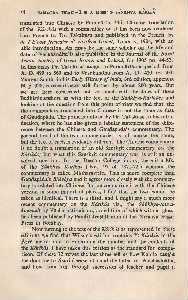Page 722 - Lokmanya Tilak Samagra (khand 2)
P. 722
74 SAMAGRA TILAK- 2 • A MISSING SANKHYA KARIKA
translated into Chinese by Paramarth. This Chinese translation
of the Kar ikas with a commentary on it has been now rendered
into French by Dr. Takakusu and published in the French by
de J'E'cole francoise d' Extreme Orient, Tome iv, 1904, with an
able introduction. An essay by the same scholar on the life and
date of Vasubandlru~is also published in the Journal of the Royal
Asiatic Society of Great Britain and Ireland, for 1905 pp. 44-53.
Itt this essay Dr. Takakusu assigns to Paramartha a period from
A. D. 499 to 569 and to Vasubandhu from A. D. 420 to 500.
Vincent Smith, in his Early History of India, 3rd edition, appendix
N, p. 328, carries it back still further by about 200 years. But
we are here concerned not so much with the dates of these
Budhistic authors as with the text of the Sankhya-Karikas; and
looking at the question from this point of view we find that the
the commentary translated into Chinese is not the same as that
of Gau~apada. The point is noticed by Dr. Takakusu in his intro-
duction, where he has also given a tabular statement of the diffe-
rence between the Chinese and Gau~apada's commentary. The
general trend of the two commentaries is of course the same,
but the text of each is evidently different. The Chinese commentary
is no doubt a translation of an old Sans~it commentary on the
Karikas; but what this Sanskrit commentary was, is still an un-
solved question. In the Deccan College library, there is a Ms.
of the Sdlikhya Karikas (No. 197 of 1871-72) wherein the
commentary is called Matharavritti. This is more complete than
(Jau~ap§.da's Bhd,hya and it agrees more closely with the commen-
tary translated into Chinese. But on comparing it with the Chinese
version in some important places, I firid that the two cannot be
taken as identical. There is a third, and I might say a much more
recent commentary on the Karikas viz., the Sankhya-tattva-
lcaumudl by Vachaspati-mishra, an edition of which with a gloss,
has been published by Pan~it Jyeeh~haram at the Niqlaya Sagar
Press in Bombay.
Now turning to the text of the Karikas as represented in these
editions we find that Wilson's edition contains 72 Karikas in the
Arya metre; and in examining the number and the contents of
the Karikds, I have taken this edition as the standard for coropa-
rison. Of these 72 verses the last three tell us how Kapila taught
the doctrine to Asuri ( verse 70 ) and the latter to Pafichashikha,
and how from him through succession of teacher and pupil it

